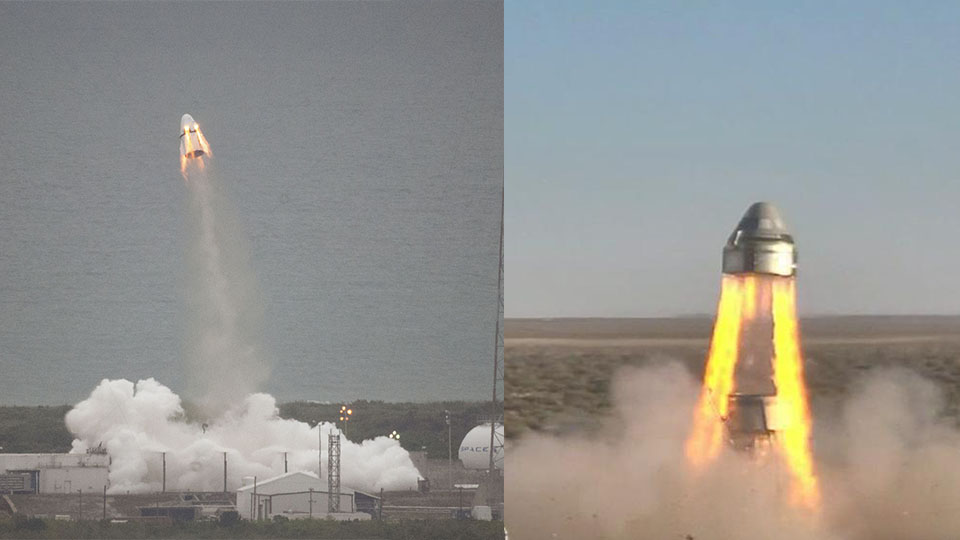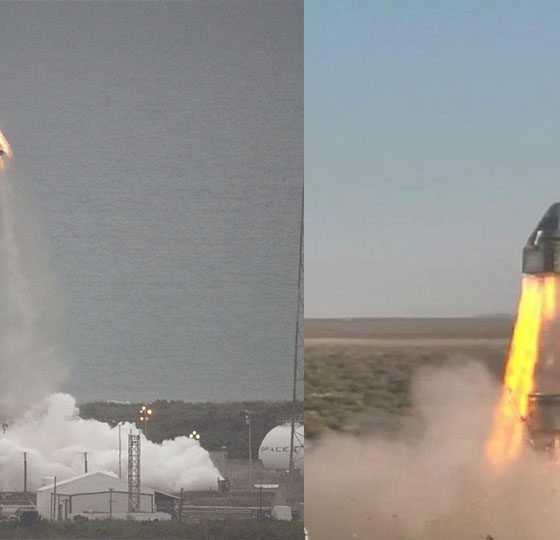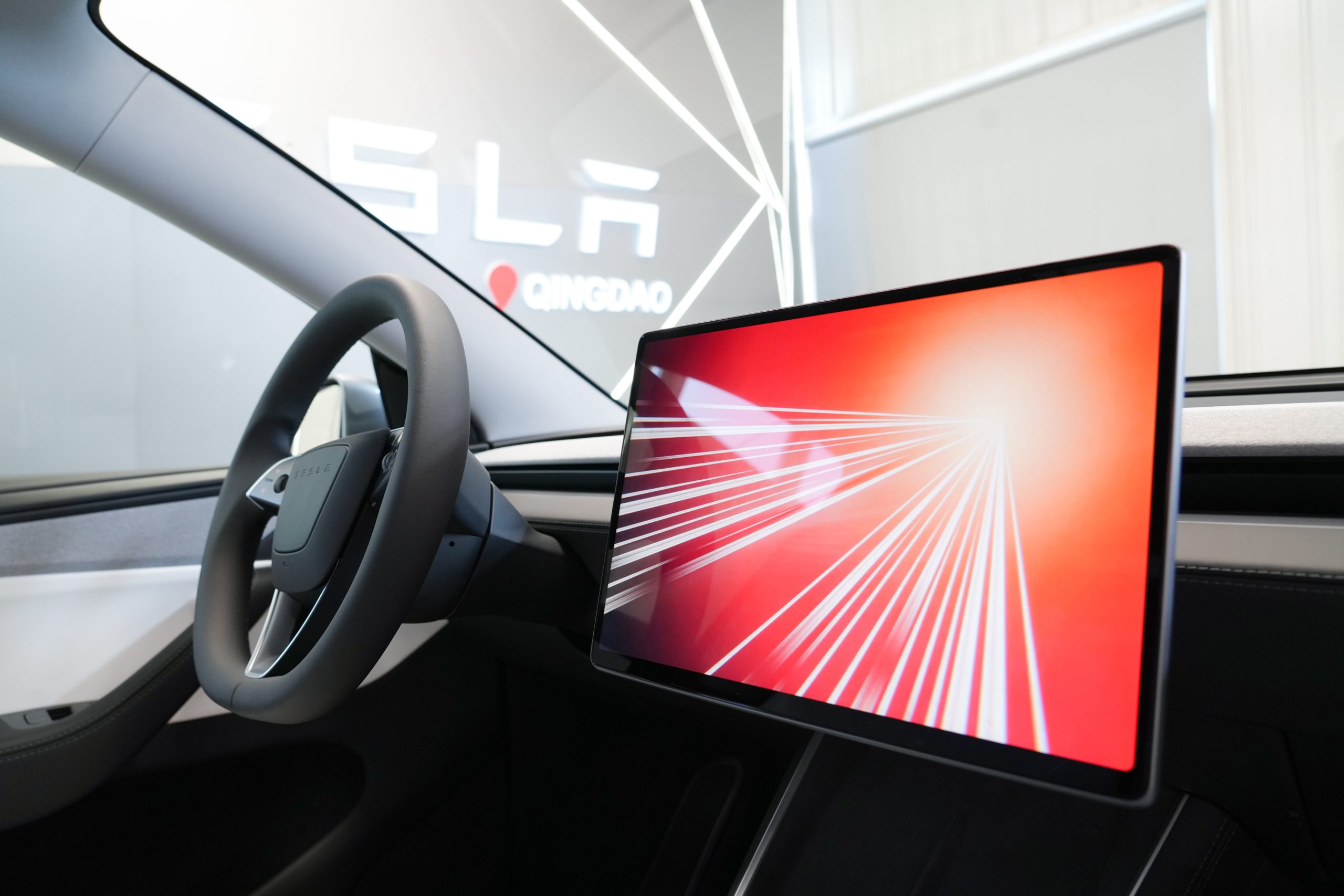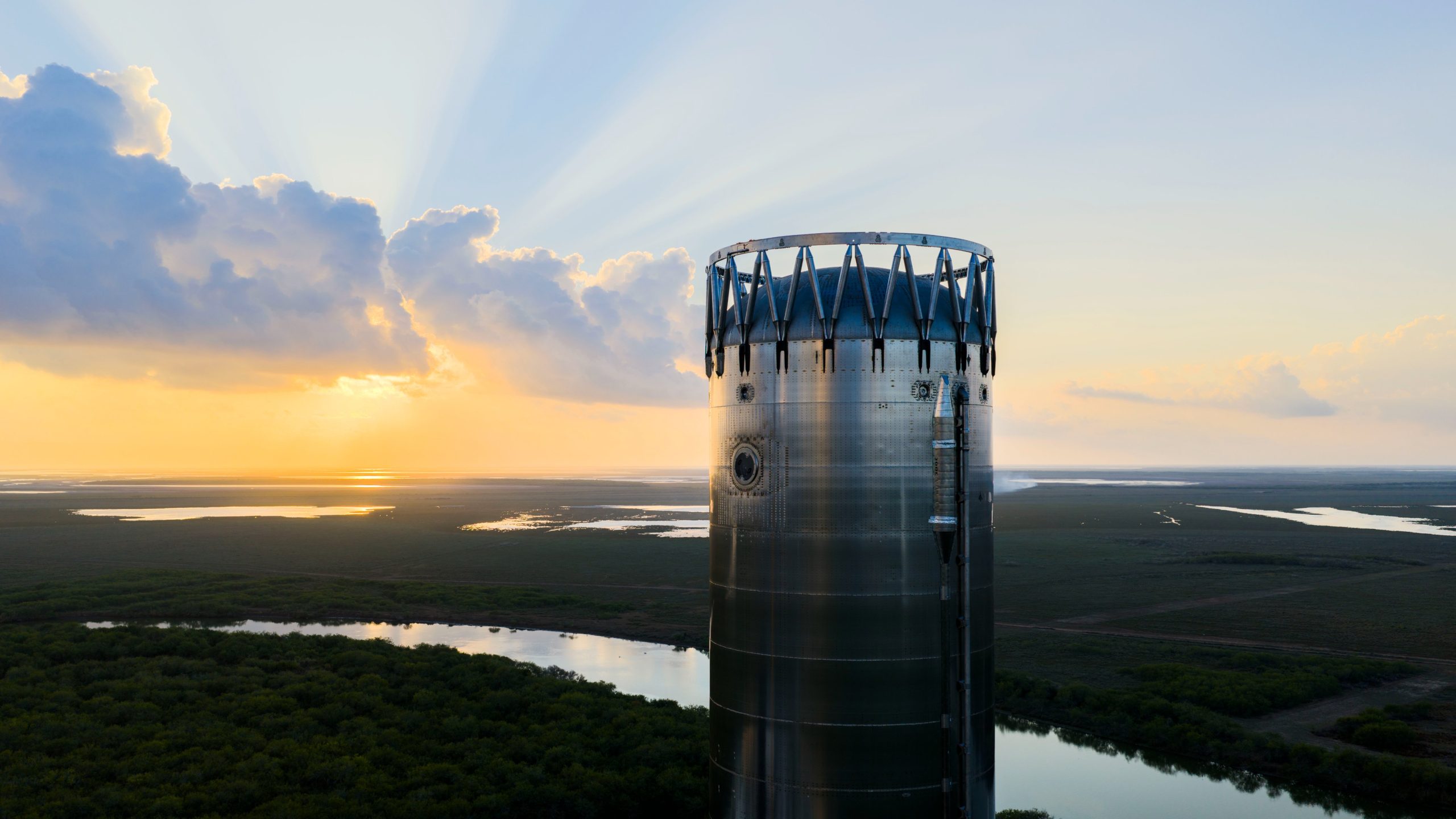

News
Boeing Starliner abort test (mostly) a success as SpaceX nears Crew Dragon static fire
On November 4th, Boeing completed a crucial pad abort test of its reusable Starliner spacecraft, successful in spite of an unintentional partial failure of its parachute recovery system. Three days later, Boeing revealed what it believed to be the cause of that anomaly in a November 7th press conference.
Meanwhile, SpaceX – having completed Crew Dragon’s pad abort test in 2015 – is preparing for an equally important In-Flight Abort (IFA) test and is perhaps just a day or two away from static firing the Crew Dragon capsule assigned to the test flight.
According to a NASA press release after the test, it “was designed to verify [that] each of Starliner’s systems will function not only separately, but in concert, to protect astronauts by carrying them safely away from the launch pad in the unlikely event of an emergency prior to liftoff.” Although the test wasn’t without flaws, the pad abort test successfully demonstrated the ability of the four launch abort engines and control thrusters to safely extricate astronauts from a failing rocket.
Those theoretical astronauts would have almost certainly survived the ordeal unharmed despite the failed deployment of one of Starliner’s three main parachutes, testing the spacecraft’s abort capabilities and redundancy quite a bit more thoroughly than Boeing intended. To put it bluntly, Boeing’s above tweet and PR claim that the failed deployment of 1/3 parachutes is “acceptable for the test parameters and crew safety” is an aggressive spin on a partial failure that NASA undoubtedly did not sign off on.
Boeing and SpaceX have both suffered failures while testing parachutes, leading NASA to require significantly more testing. However, in a November 7th press conference, Boeing revealed that Starliner’s parachute anomaly wasn’t the result of hardware failing unexpectedly under planned circumstances, but rather a consequence of a lack of quality assurance that failed to catch a major human error. Boeing says that a critical mechanical linkage (a pin) was improperly installed by a technician and then not verified prior to launch, causing one of Starliner’s three drogue chutes to simply detach from the spacecraft instead of deploying its respective main parachute.
Space is Parachutes are hard
Parachutes have been a major area of concern for the Commercial Crew Program. Both SpaceX and Boeing have now suffered failures during testing and have since been required to perform a range of additional tests to verify that upgraded and improved parachutes are ready to reliably return NASA astronauts to Earth. Although the Starliner pad abort test did indeed demonstrate the ability to land the capsule safely under two main chutes, an inadvertent test of redundancy, the series of Boeing actions that lead to the failure will almost certainly be scrutinized by NASA to avoid reoccurrences.
Boeing believes that the parachute failure won’t delay the launch of Starliner’s Orbital Flight Test (OFT), currently targeting a launch no earlier than (NET) December 17th. However, it can be said with some certainty that it will delay Starliner’s crewed launch debut (CFT), at least until Boeing can prove to NASA that it has corrected the fault(s) that allowed it to happen. SpaceX is similarly working to qualify upgraded Crew Dragon parachutes for astronaut launches, although the company has thus far only suffered anomalies related to the structural failure of parachute rigging/seams/fabric.
Abort tests galore
Boeing’s Starliner pad abort test occurred just days prior to a different major abort test milestone – this time for SpaceX. SpaceX Crew Dragon capsule C205 will perform a static fire test of its upgraded SuperDraco abort system, as well as its Draco maneuvering thrusters.
SpaceX has made alterations to the SuperDraco engines to prevent a failure mode that abruptly reared its head in April 2019, when a leaky valve and faulty design resulted in a catastrophic explosion milliseconds before a SuperDraco static fire test. Prior to its near-total destruction, Crew Dragon capsule C201 was assigned to SpaceX’s In-Flight Abort test, and its loss (and the subsequent failure investigation) delayed the test’s launch by at least six months. Crew Dragon’s design has since been fixed by replacing reusable check valves with single-use burst discs, nominally preventing propellant or oxidizer leaks.
If capsule C205’s static fire testing – scheduled no earlier than November 9th – goes as planned, SpaceX may be able to launch Crew Dragon’s in-flight abort (IFA) test before the end of 2019e. Likely to be a bit of a spectacle, Crew Dragon will launch atop a flight-proven Falcon 9 booster and a second stage with a mass simulator in place of its Merlin Vacuum engine, both of which will almost certainly be destroyed when Dragon departs the rocket during peak aerodynamic pressure.
NASA made in-flight abort tests an optional step for its Commercial Crew providers and Boeing decided to perform a pad abort only and rely on modeling and simulations to verify that Starliner’s in-flight abort safety. Assuming that NASA is happy with the results of Starliner’s pad abort and Boeing can alleviate concerns about the parachute anomaly suffered during the test, Starliner’s uncrewed orbital flight test (OFT) could launch as early as December 17th. Starliner’s crewed flight test (CFT) could occur some 3-6 months after that if all goes as planned during the OFT.
If SpaceX’s In-Flight Abort (IFA) also goes as planned and NASA is content with the results, Crew Dragon could be ready for its crewed launch debut (Demo-2) as early as February or March 2020.
Check out Teslarati’s newsletters for prompt updates, on-the-ground perspectives, and unique glimpses of SpaceX’s rocket launch and recovery processes.

Elon Musk
Tesla CEO Elon Musk teases insane capabilities of next major FSD update

Tesla CEO Elon Musk teased the insane capabilities of the next major Full Self-Driving update just hours after the company rolled out version 14.2 to owners.
Tesla Full Self-Driving v14.2 had some major improvements from the previous iteration of v14.1.x. We were on v14.1.7, the most advanced configuration of the v14.1 family, before Tesla transitioned us and others to v14.2.
However, Musk has said that the improvements coming in the next major update, which will be v14.3, will be where “the last big piece of the puzzle finally lands.”
14.3 is where the last big piece of the puzzle finally lands
— Elon Musk (@elonmusk) November 21, 2025
There were some major improvements with v14.2, most notably, Tesla seemed to narrow in on the triggers that caused issues with hesitation and brake stabbing in v14.1.x.
One of the most discussed issues with the past rollout was that of brake stabbing, where the vehicle would contemplate proceeding with a route as traffic was coming from other directions.
We experienced it most frequently at intersections, especially four-way stop signs.
Elon Musk hints at when Tesla can fix this FSD complaint with v14
In our review of it yesterday, it was evident that this issue had been resolved, at least to the extent that we had no issues with it in a 62-minute drive, which you can watch here.
Some owners also reported a more relaxed driver monitoring system, which is something Tesla said it was working on as it hopes to allow drivers to text during operation in the coming months. We did not test this, as laws in Pennsylvania prohibit the use of phones at any time due to the new Paul Miller’s Law, which took effect earlier this year.
However, the improvements indicate that Tesla is certainly headed toward a much more sentient FSD experience, so much so that Musk’s language seems to be more indicative of a more relaxed experience in terms of overall supervision from the driver, especially with v14.3.
Musk did not release or discuss a definitive timeline for the release of v14.3, especially as v14.2 just rolled out to Early Access Program (EAP) members yesterday. However, v14.1 rolled out to Tesla owners just a few weeks ago in late 2025. There is the potential that v14.3 could be part of the coming Holiday Update, or potentially in a release of its own before the New Year.
News
Tesla Full Self-Driving v14.2 – Full Review, the Good and the Bad

Tesla rolled out Full Self-Driving version 14.2 yesterday to members of the Early Access Program (EAP). Expectations were high, and Tesla surely delivered.
With the rollout of Tesla FSD v14.2, there were major benchmarks for improvement from the v14.1 suite, which spanned across seven improvements. Our final experience with v14.1 was with v14.1.7, and to be honest, things were good, but it felt like there were a handful of regressions from previous iterations.
While there were improvements in brake stabbing and hesitation, we did experience a few small interventions related to navigation and just overall performance. It was nothing major; there were no critical takeovers that required any major publicity, as they were more or less subjective things that I was not particularly comfortable with. Other drivers might have been more relaxed.
With v14.2 hitting our cars yesterday, there were a handful of things we truly noticed in terms of improvement, most notably the lack of brake stabbing and hesitation, a major complaint with v14.1.x.
However, in a 62-minute drive that was fully recorded, there were a lot of positives, and only one true complaint, which was something we haven’t had issues with in the past.
The Good
Lack of Brake Stabbing and Hesitation
Perhaps the most notable and publicized issue with v14.1.x was the presence of brake stabbing and hesitation. Arriving at intersections was particularly nerve-racking on the previous version simply because of this. At four-way stops, the car would not be assertive enough to take its turn, especially when other vehicles at the same intersection would inch forward or start to move.
This was a major problem.
However, there were no instances of this yesterday on our lengthy drive. It was much more assertive when arriving at these types of scenarios, but was also more patient when FSD knew it was not the car’s turn to proceed.
Can report on v14.2 today there were ZERO instances of break stabbing or hesitation at intersections today
It was a significant improvement from v14.1.x
— TESLARATI (@Teslarati) November 21, 2025
This improvement was the most noticeable throughout the drive, along with fixes in overall smoothness.
Speed Profiles Seem to Be More Reasonable
There were a handful of FSD v14 users who felt as if the loss of a Max Speed setting was a negative. However, these complaints will, in our opinion, begin to subside, especially as things have seemed to be refined quite nicely with v14.2.
Freeway driving is where this is especially noticeable. If it’s traveling too slow, just switch to a faster profile. If it’s too fast, switch to a slower profile. However, the speeds seem to be much more defined with each Speed Profile, which is something that I really find to be a huge advantage. Previously, you could tell the difference in speeds, but not in driving styles. At times, Standard felt a lot like Hurry. Now, you can clearly tell the difference between the two.
It seems as if Tesla made a goal that drivers should be able to tell which Speed Profile is active if it was not shown on the screen. With v14.1.x, this was not necessarily something that could be done. With v14.2, if someone tested me on which Speed Profile was being used, I’m fairly certain I could pick each one.
Better Overall Operation
I felt, at times, especially with v14.1.7, there were some jerky movements. Nothing that was super alarming, but there were times when things just felt a little more finicky than others.
v14.2 feels much smoother overall, with really great decision-making, lane changes that feel second nature, and a great speed of travel. It was a very comfortable ride.
The Bad
Parking
It feels as if there was a slight regression in parking quality, as both times v14.2 pulled into parking spots, I would have felt compelled to adjust manually if I were staying at my destinations. For the sake of testing, at my first destination, I arrived, allowed the car to park, and then left. At the tail-end of testing, I walked inside the store that FSD v14.2 drove me to, so I had to adjust the parking manually.
This was pretty disappointing. Apart from parking at Superchargers, which is always flawless, parking performance is something that needs some attention. The release notes for v14.2. state that parking spot selection and parking quality will improve with future versions.
Any issues with parking on your end? 14.1.7 didn’t have this trouble with parking pic.twitter.com/JPLRO2obUj
— TESLARATI (@Teslarati) November 21, 2025
However, this was truly my only complaint about v14.2.
You can check out our full 62-minute ride-along below:
Elon Musk
SpaceX issues statement on Starship V3 Booster 18 anomaly
The incident unfolded during gas-system pressure testing at the company’s Massey facility in Starbase, Texas.

SpaceX has issued an initial statement about Starship Booster 18’s anomaly early Friday. The incident unfolded during gas-system pressure testing at the company’s Massey facility in Starbase, Texas.
SpaceX’s initial comment
As per SpaceX in a post on its official account on social media platform X, Booster 18 was undergoing gas system pressure tests when the anomaly happened. Despite the nature of the incident, the company emphasized that no propellant was loaded, no engines were installed, and personnel were kept at a safe distance from the booster, resulting in zero injuries.
“Booster 18 suffered an anomaly during gas system pressure testing that we were conducting in advance of structural proof testing. No propellant was on the vehicle, and engines were not yet installed. The teams need time to investigate before we are confident of the cause. No one was injured as we maintain a safe distance for personnel during this type of testing. The site remains clear and we are working plans to safely reenter the site,” SpaceX wrote in its post on X.
Incident and aftermath
Livestream footage from LabPadre showed Booster 18’s lower half crumpling around the liquid oxygen tank area at approximately 4:04 a.m. CT. Subsequent images posted by on-site observers revealed extensive deformation across the booster’s lower structure. Needless to say, spaceflight observers have noted that Booster 18 would likely be a complete loss due to its anomaly.
Booster 18 had rolled out only a day earlier and was one of the first vehicles in the Starship V3 program. The V3 series incorporates structural reinforcements and reliability upgrades intended to prepare Starship for rapid-reuse testing and eventual tower-catch operations. Elon Musk has been optimistic about Starship V3, previously noting on X that the spacecraft might be able to complete initial missions to Mars.








